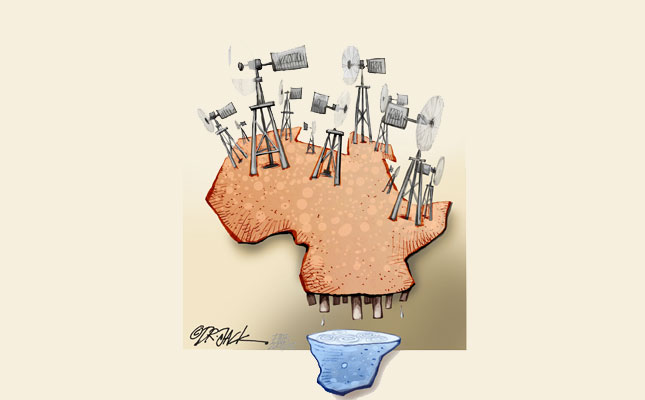
Groundwater, which accounts for approximately 99% of all liquid fresh water on earth and is distributed over the entire globe, albeit unequally, has the potential to provide societies with tremendous social, economic and environmental benefits, including climate change adaptation.
It already provides half of the volume of water withdrawn for domestic use by the world’s population, and around 25% of all water withdrawn for irrigation, serving 38% of the world’s irrigated land. Yet despite its enormous importance, this natural resource is often poorly understood, and consequently undervalued, mismanaged and even abused.
In the context of growing water scarcity in many parts of the world, the vast potential of groundwater and the need to manage it carefully can no longer be overlooked.
Groundwater storage depletion occurs when discharge exceeds recharge. Although climate variability and climate change can play a role in this, most cases of long-term groundwater storage depletion result from intensive abstraction.
The rate of global aggregated groundwater storage depletion is considerable: from the beginning of the present century, estimates are between 100km³/year and 200km³/ year (accounting for roughly 15% to 25% of total groundwater withdrawals).
Groundwater pollution reduces the suitability of abstracted groundwater for drinking purposes and affects groundwater-dependent ecosystems. There are many sources of anthropogenic groundwater pollution: most of them are located at or near the land surface, but several other sources inject pollutants into the subsurface at greater depths below the surface.
Agricultural pollution is a widespread source that often includes large quantities of nitrates, pesticides and other agrochemicals. The pollution of groundwater is a virtually irreversible process; once polluted, aquifers tend to remain polluted.
Agriculture
Groundwater is a critical resource for irrigated agriculture, livestock farming and other agricultural activities, including food processing. In order to meet global water and agricultural demands by 2050, including an estimated 50% increase in food, feed and biofuel demand relative to 2012 levels, it is of critical importance to increase agricultural productivity through the sustainable intensification of groundwater abstraction, while decreasing the water and environmental footprints of agricultural production.
A perennial and reliable source of shallow groundwater can be an important source for smallholder farmers. Regions heavily reliant on groundwater for irrigation include North America and South Asia, where 59% and 57% of the areas equipped for irrigation use groundwater, respectively.
In sub-Saharan Africa (SSA), where the opportunities offered by the vast shallow aquifers remain largely underexploited, only 5% of the area equipped for irrigation uses groundwater.
It is estimated that agricultural pollution has overtaken contamination from settlements and industries as the major factor in the degradation of inland and coastal waters.
Nitrates from chemical and organic fertilisers are the most prevalent anthropogenic contaminants in groundwater globally.
Insecticides, herbicides and fungicides, when improperly applied or disposed of, can pollute groundwater with carcinogens and other toxic substances.
Evidence suggests that laws and regulations to prevent or limit diffuse groundwater pollution from agriculture, and their enforcement in particular, are generally weak. Policies addressing water pollution in agriculture should be part of an overarching agriculture and water policy framework at the national, river basin and aquifer level.
Rural electrification has been a principal driver for groundwater development, especially where rural power grids have been extended into areas that would otherwise have relied on diesel power or wind energy. Advances in solar technology have witnessed the development of solar-powered irrigation systems (SPIS), adopted at scale to service farming operations.
However, there is a risk of unsustainable water use if SPIS implementation is not adequately managed and regulated.
Groundwater in Africa
Africa possesses large groundwater resources, and while not all of this groundwater is available for abstraction, the volume is estimated to be more than 100 times that of its annual renewal of freshwater resources.
The development of groundwater has great potential to satisfy the need for rapidly increasing water supply across SSA, both for human survival and to promote economic development. About 400 million people in SSA still don’t have access to even basic water services.
Most countries in West and Central Africa have little groundwater storage, but high annual rainfall and therefore regular recharge. Conversely, many countries in East and Southern Africa have considerable groundwater storage despite very low levels of recharge.
This storage will provide a significant buffer before abstraction impacts the regional groundwater system. However, current groundwater pumping will ultimately be at the expense of future generations.
Only 3% of the total cultivated land in SSA is under irrigation, and only 5% of that is irrigated with groundwater. The development of groundwater could act as a catalyst for economic growth by increasing the extent of irrigated areas and therefore improving agricultural yields and crop diversity.
The further development of groundwater in SSA is not currently limited by a lack of groundwater, but rather by a lack of investment, most notably in infrastructure, institutions, trained professionals and knowledge of the resource.
Management
Groundwater management aims to control the abstraction and quality of groundwater, and to address the effects of groundwater abstraction on ecosystems, surface water, land subsidence and more. Perhaps one of the most critical components of groundwater management is the control of the location and quantity of water withdrawals from aquifers.
Deployment of several groundwater management tools is contingent upon first having the legal and institutional structures in place that grant authority for their use and enforcement. However, not all management occurs through government. Communities and/or groundwater users themselves may independently choose to manage well- siting and groundwater abstractions.
The most sustainable and cost-effective approach to managing groundwater quality is to ensure its adequate protection, thus avoiding contamination. This can be achieved through vulnerability mapping, development of groundwater protection zones, and land-use planning.
Particular attention should be given to the conjunctive management of surface water and groundwater resources, and to the potential for ‘nature-based’ solutions. Integration with environmental management, land-use management, and the management of the space and resources of the subsurface are all important issues within the scope of integrated management.
Managed aquifer recharge (MAR) is an integrated approach that allows the replenishment of aquifers to complement storage dams, and provides a cost-effective alternative that minimises evaporation and environmental impacts. MAR can also be used to retain unharvested urban storm water and recycled water, to be made available for productive use when needed.
At the watershed scale, MAR can be used to maintain environmental water flow and its availability, creating lags in water discharges to a stream.
The application of MAR has increased tenfold over the last 60 years, but there is still ample scope for further expansion from the current 10km³/year to probably around 100km³/year.
The views expressed in our weekly opinion piece do not necessarily reflect those of Farmer’s Weekly.
This is an edited excerpt from a 2022 Unesco World Water Assessment Programme report titled, ‘Groundwater: Making the invisible visible’.













